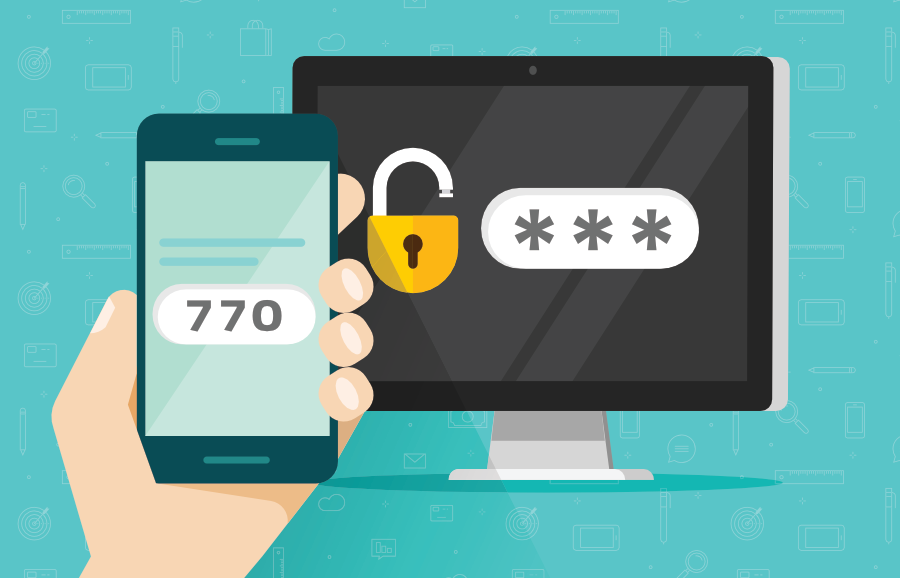Two-factor authentication (2FA) is a security system that requires two distinct forms of identification in order to access something. Two-factor authentication can be used to strengthen the security of an online account, a smartphone, or even a door. 2FA does this by requiring two types of information from the user a password or personal identification number (PIN), a code sent to the user’s smartphone, or a fingerprint before whatever is being secured can be accessed.
Two-factor authentication consists of combining two of the following:
- Something you are aware of (your password)
- Something you own (such as a text with a code sent to your smartphone or another device, or a smartphone authenticator app)
- Something you’re doing (biometrics using your fingerprint, face, or retina)

Authentication Factors:
- Knowledge Factor: A knowledge factor is something that the user is aware of, such as a password, personal identification number (PIN), or another sort of shared secret.
- Possession Factor: To approve authentication messages, a possession factor is something that the user owns, such as an ID card, a security token, a telephone, a mobile device, or a smartphone app.
- Biometric Factor: A Biometric factor, also known as an inference factor, is anything that is inherent in the physical self of the user. Personal traits mapped from physical characteristics, such as fingerprints confirmed by a fingerprint reader, may be included. Facial and voice recognition, as well as behavioral biometrics such as keyboard dynamics, gait, or speech patterns, are other often employed inference variables.
- Location Factor: The location from which an authentication attempt is conducted is typically used to identify a location factor. This can be enforced by limiting authentication attempts to specific devices in a specific location or by tracking the geographic source of an authentication attempt based on the source Internet Protocol address or some other geolocation information derived from the user’s mobile phone or another device, such as Global Positioning System (GPS) data.
- Time Factor: A time factor limits user authentication to a defined time window for logging on and prevents access to the system outside that window.
Working of Two-Factor Authentication:
The process of enabling two-factor authentication differs based on the application or vendor. But the general processes are as follows :
- The program or website prompts the user to log in.
- The user inputs what they know, which is often their login and password. The server then discovers a match and recognizes the user.
- The website generates a unique security key for the user for processes that do not require passwords. The key is processed by the authentication tool, and it is validated by the site’s server.
- The user is then prompted to begin the second login stage. Although this stage can take several forms, the user must demonstrate that they have something that only they have, such as biometrics, a security token, an ID card, a smartphone, or another mobile device. This is the factor of inference or possession.
- The user may then be required to input a one-time code produced during step four.
- The user is authenticated and provided access to the application or website after supplying both factors.
Two-Factor Authentication Security:
A 2FA-enabled account is far more secure than a simple username and password login, but it is not completely foolproof.
- 2FA Security through Text Message: One of the most important 2FA security issues for text messaging is the ability of users to preserve their cell phone numbers even when switching providers. Hackers can use mobile number portability to represent you and swap your number to a phone they control.
- Applications for Authentication: Because leaving your smartphone unattended at work or losing it while traveling puts your accounts at risk, 2FA Security Authentication apps like Google Authenticator are inclined to devise theft.
Similarly, security tokens, which are often regarded as one of the most secure types of 2FA, can be compromised at the manufacturer level.
2FA Bio-Metric Security:
People frequently believe that biometric security is impenetrable. The truth is rather different. Hackers can gain account access even when biometrics are enabled, just like any other security mechanism.
Two-Factor Authentication Best Practices:
Two-factor authentication provides ample protection but can be best practiced using the following ways :
- Do not use your personal phone number: Phone companies are renowned for being duped into changing account information by skilled hackers. Instead, create a personal Google Voice number that you may keep indefinitely and that no phone carrier can modify.
- Account resets through email should not be used: It is more convenient to reset your passwords via email. This is because it allows a hacker to easily overcome other 2FA techniques and access the account with just a username and password.
- Use a mix of authentication mechanisms: Multiple 2FA methods can be used to safeguard multiple accounts. And the more 2FA options you employ, the more secure your data will be.
Two-Factor Authentication Examples:
- In Google: To guard against the ongoing threat of phishing – fraudulent efforts to get passwords and other sensitive details through trustworthy appearing emails or websites. Google provides several types of two-factor authentication. In addition to the usual password, users can enter a one-time security code received through SMS or voice call or generated on the Google Authenticator app, which is available on Android and Apple’s mobile operating system iOS. Within their Google Account, users can also submit a list of trusted devices. If a user attempts to log in from a device that is not on the list, Google will issue a security warning.
- Epic Games: Windows Central explains why you should double-protect this account in particular: a lot of scammers target the game’s younger users with enticing links that offer free Vbucks, and Fortnite in-game money. These are phishing scams designed to steal your login credentials and gain access to your account (as well as any payment information you’ve saved to purchase Vbucks). If you have Fortnite-obsessed children, you should probably enable 2FA on your Epic Games account. To enable 2FA for Fortnite, go to your account settings page, click on the PA tab, and then select either enable authentication app or enable email authentication under the two-factor authentication title.
- In Apple: Apple account holders can utilize two-factor authentication (2FA) to ensure that their accounts can only be accessed from trustworthy devices. If a user attempts to access their iCloud account from a separate computer, they will require not only their password but also a multi-digit code sent by Apple to one of their devices, such as their iPhone.




